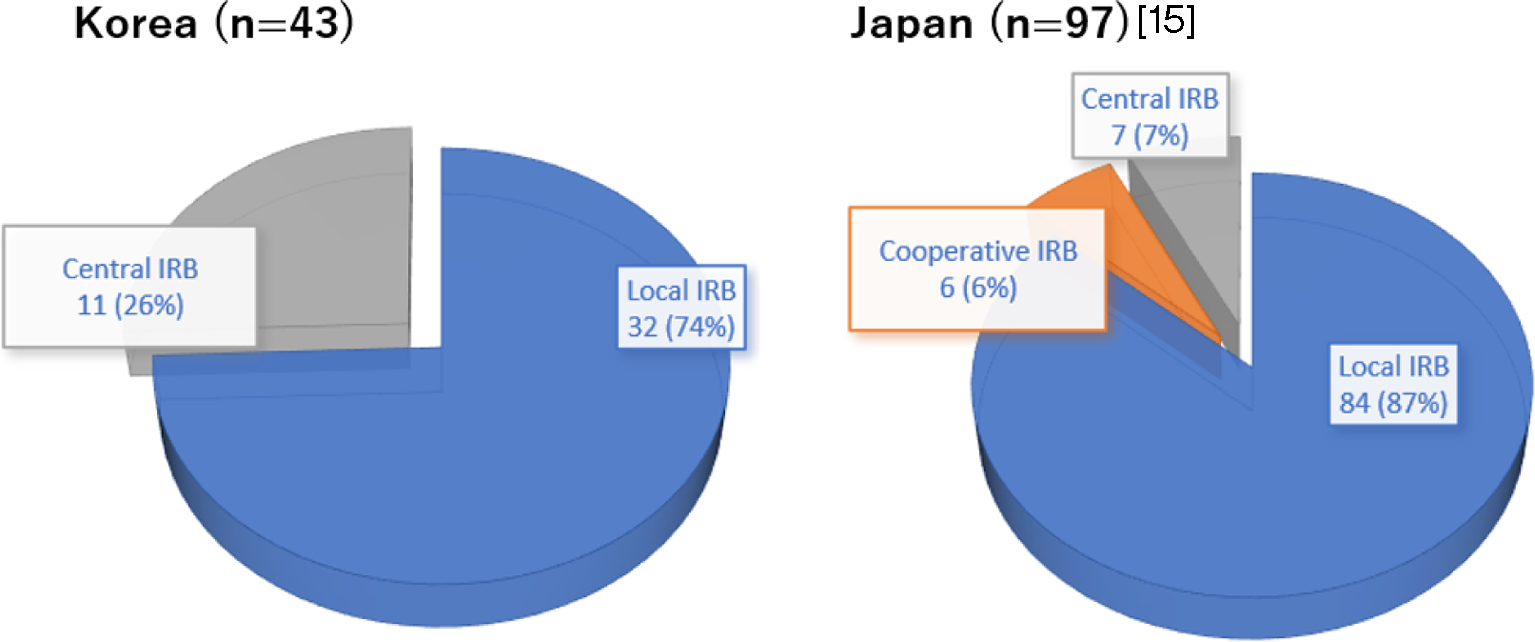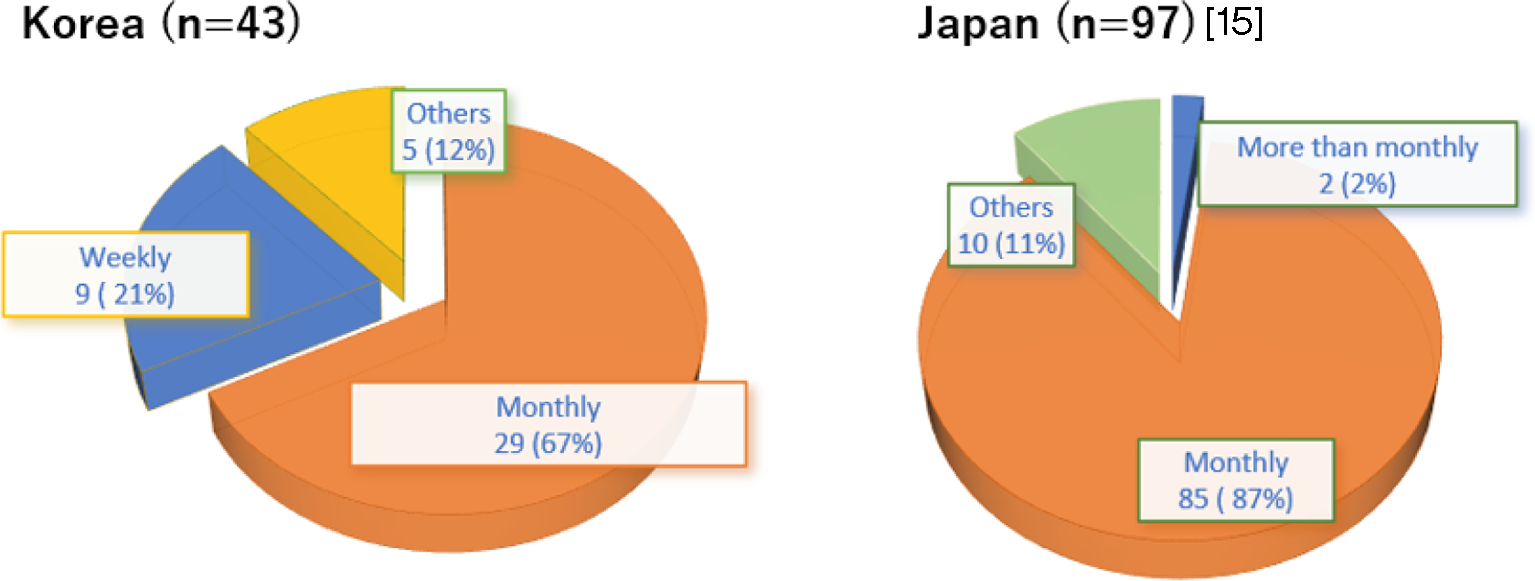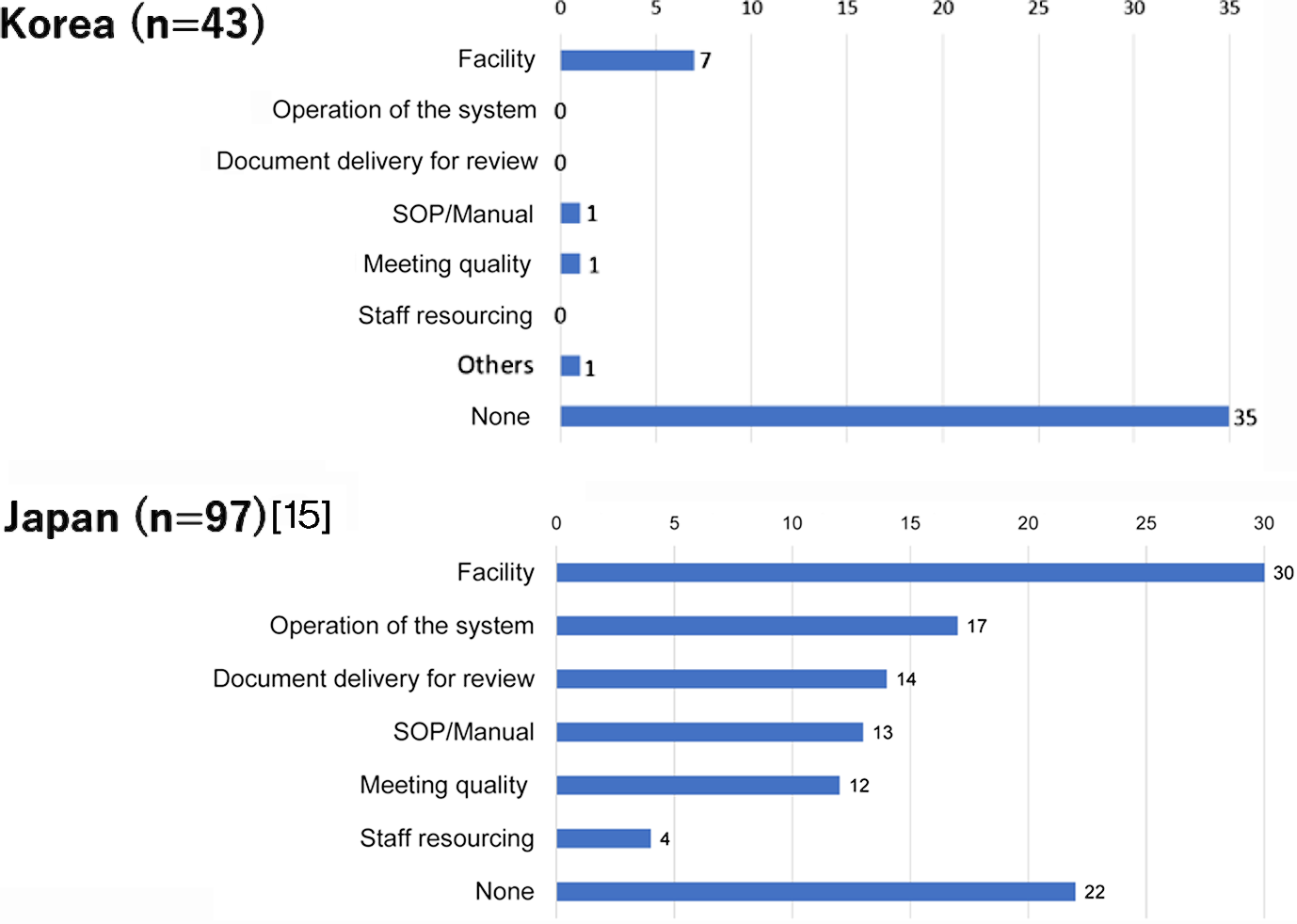2021 Volume 3 Issue 2 Pages 60-64
2021 Volume 3 Issue 2 Pages 60-64
The worldwide pandemic of the novel coronavirus disease 2019 (COVID-19) had an immediate impact on acceleration of the introduction of alternative methods of operation for Institutional Review Boards (IRBs) defined in ICH E6 (GCP) guidelines. This study was carried out to compare the operational status of IRBs in Korea during the COVID-19 outbreak with the results of a survey conducted in Japan during the same period. An online survey of IRBs was conducted in Korea from May 5 to July 31, 2020. A self-administered questionnaire about the profiles of IRB organization, impact of the COVID-19 outbreak on IRB operation, and status of using Information and Communication Technology (ICT) tools such as electronic document management systems and digital communication systems was distributed by e-mail to 169 IRBs in Korea. Responses were collected electronically via the online questionnaire survey. The survey results were then analyzed and compared with those from our previous survey in Japan containing the same questionnaire items, which was distributed to 520 IRBs. A total of 43 IRBs in Korea participated in the survey, and the results were compared with those from 97 Japanese IRBs. Although the local IRB has the largest share in both Japan and Korea, the frequency of review meetings and the impact of the COVID-19 outbreak were greater in Korea than in Japan. Both countries used ICT during the COVID-19 outbreak, but Korea was less concerned about ICT use compared to Japan.
A comparison of IRB operations in Korea and Japan during the COVID-19 outbreak showed similarities and differences regarding the impact of the pandemic, which could be attributed to the unique profiles of the IRBs and their operations in both countries. Effective utilization of ICT tools will be expected in the future to improve IRB operations.
The coronavirus disease 2019 (COVID-19) outbreak has had a significant impact on the conduct of clinical trials worldwide [1]. Regulatory authorities in various regions and countries issued notifications regarding the response to the outbreak [2,3,4,5,6], and pharmaceutical companies and Contract Research Organizations (CROs) presented their response policies [7,8,9,10]. The authorities also issued Investigational Review Board (IRB)-specific notifications [11, 12], and each IRB responded accordingly. Korea was no exception when difficulties arose in continuing clinical trials following COVID-19 guidelines issued by the Korean Centers for Disease Control and Prevention (KCDC) [13, 14]. As IRBs in particular are responsible for protecting the rights and welfare of human subjects in clinical trials, they are expected to make various efforts in accordance with national policies. This study aimed to investigate the status of using electronic systems for document management and communication at IRBs in Korea before and during the outbreak as part of an Asian survey in comparison with our previous survey results from IRBs in Japan [15].
An online questionnaire (Table 1) was designed and distributed via e-mail to 169 IRBs, an independent body defined in ICH E6, in the Korean Association of Institutional Review Boards (KAIRB) on May 5, 2020. The queried items were the same as those for 520 IRBs in Japan addressed at around the same time [15]. Anonymous responses containing no personal information were collected electronically in both countries from the online questionnaire survey conducted from May 5, 2020 to July 31, 2020. Both sets of survey results were analyzed with a focus on a comparative perspective.
| 1. Background | Name of Investigational Review Board (IRB) |
| Type of IRB | |
| Frequency of review testing | |
| 2. Impact of COVID-19 outbreak | For new clinical trials to be submitted, which IRB procedures were affected by the coronavirus disease (COVID-19) outbreak? |
| For ongoing clinical trials to be reviewed, which IRB procedures were affected by the COVID-19 outbreak? | |
| 3. Use of an electronic document management system | Do you use any electronic document management system for IRB/IEC operations? |
| Did you use such a system for your IRB prior to the COVID-19 outbreak? | |
| How satisfied are you with the system? | |
| Do you have any concerns regarding the use of such a system for IRB operations? | |
| 4. Use of a digital communication system | Do you use any digital communication system for IRB/IEC operations? |
| Did you use such a system for your IRB prior to the COVID-19 outbreak? | |
| How satisfied are you with the system? | |
| What written procedures have you developed to guide the use of the system? | |
| Do you have any concerns regarding the use of such a system for IRB operations? |
A total of 43 out of the 169 IRBs registered with KAIRB responded during the survey period from May 5, 2020 to July 31, 2020. In this survey, we defined “local IRBs” as those IRBs established by individual clinical trial sites to review their own clinical trials, and “central IRBs” as those established by an external organization to collectively review trials conducted at multiple clinical trial sites as well as our survey of IRBs in Japan [15]. Based on this definition, 32 local IRBs and 11 central IRBs participated in the survey in Korea. In Japan, 84 local IRBs, 7 central IRBs, and 6 cooperative IRBs, established by affiliated sites to review their trials, responded to the questionnaire addressed to 520 IRBs (Fig. 1).

Types of Investigational Review Boards (IRBs).
In Korea, the most common frequency of review meetings was “Monthly” (67%), followed by “Weekly” (21%) (Fig. 2). Of the 11 central IRBs, 10 (90%) held a review meeting on a monthly basis. For local IRBs, 19 (59%) of the 32 IRBs held monthly meetings, while 13 IRBs (41%) met more than once a month (weekly, twice a month, etc.). In a survey conducted in parallel with 97 IRBs in Japan, local IRBs (87%) were the majority. Eighty-seven percent of IRBs held monthly review meetings [15].

Frequency of Investigational Review Boards (IRBs) review meetings.
Figure 3 shows the IRB procedures affected by the outbreak during the review of “New” and “Ongoing” clinical trials that were considered by an IRB. In Korea, 47 responses were received regarding “New clinical trials” and 45 responses regarding “Ongoing clinical trials” from 43 IRBs, with multiple answers accepted except for ‘No impact’. Of these 43 IRBs, “No impact” was reported in 12 “New clinical trials” and 19 “Ongoing clinical trials.” In other words, some effect was seen in 31 IRBs (72%) for “New clinical trials” and in 24 IRBs (56%) for “Ongoing clinical trials” out of 43 IRBs. The outbreak was found to have more impact on “New clinical trials,” especially in “Scheduling/holding the review meeting.” In Japan, half of the IRBs reported no impact (New clinical trials: 56%, Ongoing clinical trials: 53%), while the most affected activity was “Scheduling/holding of review meetings” [15].

Investigational Review Board (IRB) procedures affected by the COVID-19 outbreak (multiple responses permitted).
Table 2 shows the overall utilization status of ICT tools for IRBs. The number of IRBs using an electronic document management system increased from 23 (53%) before COVID-19 to 29 (67%) during COVID-19 among the 43 IRBs in Korea. In Japan, out of the 97 IRBs, the figure before COVID-19 was 24 (25%), which increased to 26 (27%) during COVID-19.
As for digital communication systems, including web-based meetings and TV conference systems, Korea’s utilization rate increased from 16% before COVID-19 to 42% during, while Japan’s rate rose from 4% to 39%. Regarding usability in the satisfaction assessment, 15 responders out of 16 IRBs (94%) and 5 out of 5 IRBs (100%) answered “Good” or “OK” for the use of electronic document management system and digital communication system in Korea, respectively. These rates were 16/17 (45%) and 14/17 (82%) in Japan, respectively.
Concerns regarding digital communication systemsFigure 4 shows the specific concerns regarding the use of digital communication systems in IRBs, analyzed in seven categories based on free-text responses. Thirty-five of the 43 Korean IRBs (81%) reported no concern regarding the use of ICT tools. In the same survey in Japan, only 22 (23%) of the 97 IRBs reported that they were not concerned about ICT tools. In particular, “Facility” (31%) was the most cited concern in Japan, followed by other items including “Operation of the system”, “Document delivery for review”, and “SOP/Manual” [15].

Concerns regarding the use of a digital communication system in Investigational Review Boards (IRB) (multiple responses permitted).
In this study, we noted similarities and differences in the operation of the Korean and Japanese IRBs when travel restrictions due to the COVID-19 outbreak became more stringent, by comparing the Korean results with those obtained in a parallel study conducted in Japan at around the same time. Similar types of IRBs participated in this survey. In both Korea and Japan, local IRBs accounted for the majority (Korea: 74%, Japan: 87%). They also experienced a greater impact from the outbreak with respect to the operation of new clinical trials. However, this effect may not be limited to just these two countries [1], and it is probable that new clinical trials were more likely to be influenced by the outbreak because the review of new studies usually requires more items to be confirmed and discussed in the IRB review meeting compared to that for ongoing studies.
Differences between the two countries were found in the frequency of IRB review meetings and the degree of overall influence of the outbreak. Compared to Japan, where meetings were generally held only monthly, IRB review meetings were held more frequently in Korea. Due to the spread of infectious diseases, measures to prevent infections, such as travel restrictions and visits to IRB offices, were taken. Therefore, in order to continue IRB review activities during the outbreak, it was necessary to shift from face-to-face reviews to non-contact reviews quickly, such as online meetings and other alternative ways. As a result, it is likely that the impact of the outbreak was demonstrated in Korea, particularly in the category of “scheduling/holding review meetings”. This study did not evaluate the change in the frequency of IRB review meetings before and during the pandemic, because other means such as e-mail and telephone [12] may have been used as alternative methods in addition to the digital communication system. Of the total IRBs surveyed in Korea, 53% utilized an electronic document management system before the COVID-19 outbreak, compared to 25% in Japan. Moreover, usage was continuously promoted in Korea (14 percentage points increase during the outbreak), whereas little progress was observed in Japan (2 percentage points). The introduction of an electronic document management system is not easy because it requires a lot of time and money, in addition to organizational efforts, to facilitate the system. Nevertheless, a majority of Korean IRBs (67%) are utilizing this type of system during the outbreak, suggesting that Korean national strength in developing infrastructure may have led to this overwhelming difference from Japan.
Regarding the use of a digital communication system before and during the outbreak, Korea has maintained higher utilization than Japan, although Japan began to catch up during the outbreak. In general, a digital communication system can be installed at a low cost, and its setup can be completed more quickly compared to that of an electronic document management system. As a result, both Japan and Korea could accelerate the utilization rates of this type of communication system immediately during the outbreak. However, despite reaching similar rates of utilization, many more concerns have been reported in Japan compared to that in Korea.
This may also be related to social differences in the IT-related environment between Japan and Korea and may not be limited to clinical trials and research activities.
Korea has promoted governance by digitization at the national level since it established the National Computerization Agency (NCA) in 1987 [16]. Japan, in contrast, has only recently embarked on its own digital reform process, including the opening of a digital agency [17]. The United Nations Department of Economic and Social Affairs (NDESA) conducted an “E-Government Survey” based on three indicators: an online service index, human capital index, and telecommunications infrastructure index [18]. In 2020, Korea was ranked 2nd out of the 193 member nations of the United Nations, while Japan was ranked 14th. It is considered that such a difference in the overall national system might have resulted in less confidence in Japan. Despite these environmental differences, the IRBs in Japan and Korea have been able to continue reviewing activities by utilizing ICT tools such as an electronic document management system and a digital communication system during the pandemic. The high level of satisfaction with each system demonstrated the usefulness of ICT tools in the IRB.
Similarities and differences regarding the impact of the COVID-19 outbreak on IRB operations, the action taken, and concerns about the use of ICT tools to maintain continuous operations were identified through a questionnaire survey in Korea, and the results were compared with those of Japan. It was confirmed that ICT tools were actively used in continuous review activities during the COVID-19 outbreak in both countries, despite differences in the state of preparedness to use such tools and systems. More effective use of ICT tools will be expected in the future through further improvement in the utilization method.
The authors have no conflicts of interest directly relevant to the content of this article.
We would like to thank the Korean Association of IRB (KAIRB).